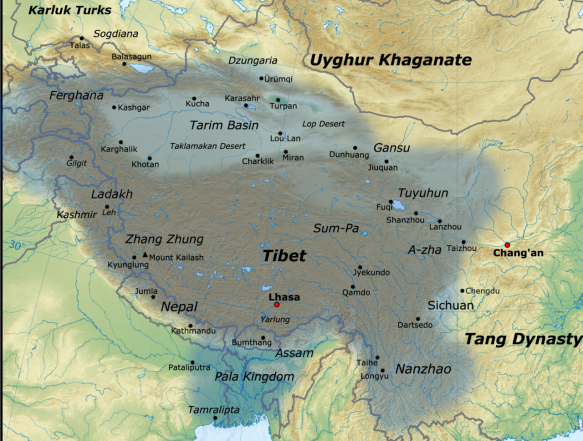The Tibetan Empire at its greatest extent between the 780s and the 790s CE.
About 560 AD a local Tibetan chieftain, Gnam-ri slon mtshan, revolted against his Zan-Zun overlords and established the Yarlung dynasty. By about 630 his successor Sron btsan sgampo had unified the Tibetan clans and founded an empire which over the next two centuries fought expansionist wars. After 841 this broke up, but successor states survived and continued to maintain armies, often fighting each other. The last Yarlung ruler was Rgyal-sras of Tsong-kha, a principality on the border of the Hsi-Hsia state, who died in 1065 Arabs, Chinese and Bengalis were all at various times associated with the Tibetan empire. Tibetan armies in India and west of the Parnirs seem to have been small, and their Ferghanan allies are best regarded as Turks rather than Arabs Combined Tibetan-Chinese armies were usually under Chinese command. The Abbasid troops represent hose captured by the T’ang in 801 thought to have been either taken prisoner by the Tibetans in an otherwise unknown western campaign and incorporated into the army, or failed rebels or dissidents who had voluntarily joined it. They were under Tibetan command. Nepalese and Nan-chao allies cannot be used with each other, nor with any other allies apart from Ch’iang. The exact nature of Nepalese troops is conjectural, but they are described as cavalry. They could be a large majority of a Tibetan-Nepalese force. Tibetan cavalry are described in the T’ang Annals as armed with very long lance, both man and horse completely mailed except for the eyes, and invulnerable to swords and strong bows. There is no suggestion anywhere that they charged at the gallop. The same T’ang source describes them as fighting dismounted and arrayed in ranks. Though bow-armed they favoured close combat. Tibetans were skilled makers of siege equipment.
#
The Tibetan kingdom was at its height during the seventh and eighth centuries. After 842 a schism in the ruling lineage led to decline, decentralization, and civil wars. The Tibetan kingdom submitted to Genghis Khan in the early 13th century and formally acknowledged Mongol overlordship in 1247. Records of the Shang dynasty in China (ended c. 1122 b. c. e.) mention a tribal people called the Qiang (Ch’iang) living in the borderlands of western China. They later moved westward into the Tibetan highlands. Early Tibetan history is mostly gleaned from Chinese historical records, most notably the Dun- huang Records (Tun-huang Records). The rise of the Tibetan Kingdom was contemporaneous with the rise of the Tang (T’ang) dynasty in China; its capital city was called Ra-sa (later Lhasa). In 641 Emperor Taizong (T’ang-tsung) of the Tang dynasty agreed to marry his kinswomen Princess Wenzheng (Wen-ch’eng) to the Tibetan ruler. She went with a huge entourage of attendants and Chinese artisans and introduced many aspects of Chinese civilization, such as paper and tea, to Tibet.
During the same period Tibetan rulers sent representatives to India to learn about Buddhism; they introduced to Tibet a written script derived from Sanskrit. Tantric or Vajrayana Buddhism from northeastern India was introduced to Tibet; it replaced and assimilated Tibetan shamanistic beliefs called Bon. In 779 Buddhism became Tibet’s state religion, monastic lands became tax-free, and monks enjoyed the same status as nobles, both groups owning the serfs who tilled the land.
The Tibetan kingdom reached its zenith between 755 and 797. Its ascendancy coincided with the An Lushan (An Lu-Shan) Rebellion that rocked the Tang dynasty in the mid-eighth century, and its aftermath when Chinese power was reduced. The rebellion compelled the withdrawal of Chinese garrisons from Central Asia, leading to the submission of some of the minor states in the region to Tibetan hegemony. Tibetan power penetrated into Gansu (Kansu) province in northwestern China and threatened both the strategic Chinese outpost at Dunhuang and Hami and even the Chinese capital Chang’an (Ch’ang-an). To contain Tibet, Tang China made peace with its other neighbors, the Uighur Empire in the north, the Arabs in the west, and the Nanzhao (Nanchao) in the south, after 787. In 792 the Tibetan army was badly defeated by the Uighurs. In 821–822 Tibet made peace with both China and the Uighurs. By the mid-ninth century civil wars within the royal family and wars between powerful nobles and monks had fractured the Tibetan kingdom.
In the early 13th century Tibet surrendered to Genghis Khan and was thus spared Mongol invasion. In 1247 it acknowledged Mongol overlordship and paid taxes to the Mongol court but was not subjected to a Mongol occupation force. Kubilai Khan converted to Tibetan Buddhism, greatly favored Tibetan monks, and encouraged his fol- lowers to convert. A Tibetan monk gave the Mongols a new written script called the Phagspa script named after its inventor; it replaced the earlier script based on Uighur.
Further reading: Sinor, Denis ed. The Cambridge History of Early Inner Asia. Cambridge: Cambridge University Press, 1990; Beckwith, Christopher I. The Tibetan Empire in Cen- tral Asia: A History of the Struggle for Great Power among Tibetans, Turks, Arabs, and Chinese During the Early Mid- dle Ages. Princeton: Princeton University Press, 1987; Rich- ardson, H. Tibet and its History. Oxford: Oxford University Press, 1962; Twitchett, Denis, ed. The Cambridge History of China, Volume 3, Sui and T’ang China, 589–906. Cam- bridge: Cambridge University Press, 1979.
